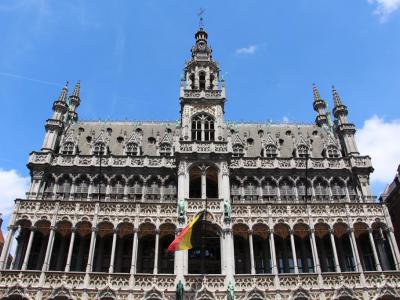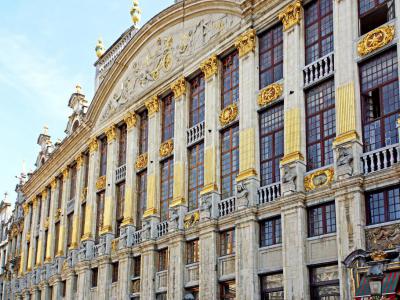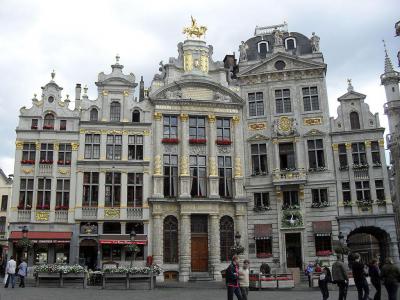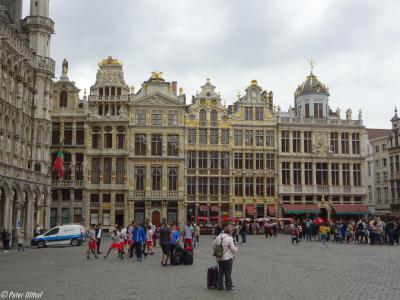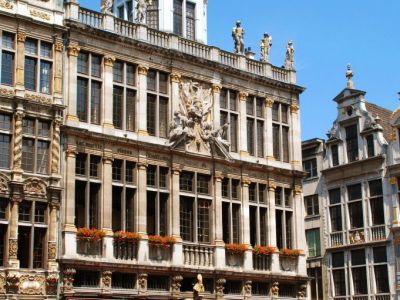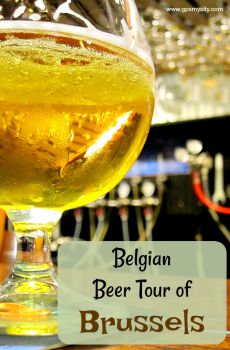
Grand Place Walking Tour (Self Guided), Brussels
World-famous for its imposing Baroque-style buildings, such as the Town Hall, the King's House and the House of Dukes, the Grand Place of Brussels a whole is indisputably a masterpiece of human creative genius, with a special quality of homogeneity and coherency.
The buildings around the Grand Place, all different but built within a very short period, admirably illustrate the Baroque architecture of the turn of the 17th and 18th centuries, with special treatment in a local (and therefore unique style) of the gables and ornamentation.
Lining each side of the square is a number of guild-houses and a few private houses which, in their current form, are largely the result of reconstructions after the French bombardment of 1695. During the Middle Ages and later, many cities in Belgium had guilds with a stake in the city's administration. These guilds were very wealthy and held tremendous political power, thus their wealth position was often reflected in ornate and impressive buildings, each bearing their own name and distinguishing features.
Take this self-guided tour to better appreciate the architectural wonder of the Grand Place, which perfectly encapsulates and vividly illustrates the social and cultural quality of this important political and commercial center.
The buildings around the Grand Place, all different but built within a very short period, admirably illustrate the Baroque architecture of the turn of the 17th and 18th centuries, with special treatment in a local (and therefore unique style) of the gables and ornamentation.
Lining each side of the square is a number of guild-houses and a few private houses which, in their current form, are largely the result of reconstructions after the French bombardment of 1695. During the Middle Ages and later, many cities in Belgium had guilds with a stake in the city's administration. These guilds were very wealthy and held tremendous political power, thus their wealth position was often reflected in ornate and impressive buildings, each bearing their own name and distinguishing features.
Take this self-guided tour to better appreciate the architectural wonder of the Grand Place, which perfectly encapsulates and vividly illustrates the social and cultural quality of this important political and commercial center.
How it works: Download the app "GPSmyCity: Walks in 1K+ Cities" from Apple App Store or Google Play Store to your mobile phone or tablet. The app turns your mobile device into a personal tour guide and its built-in GPS navigation functions guide you from one tour stop to next. The app works offline, so no data plan is needed when traveling abroad.
Grand Place Walking Tour Map












Guide Name: Grand Place Walking Tour
Guide Location: Belgium » Brussels (See other walking tours in Brussels)
Guide Type: Self-guided Walking Tour (Sightseeing)
# of Attractions: 9
Tour Duration: 1 Hour(s)
Travel Distance: 0.3 Km or 0.2 Miles
Author: audrey
Sight(s) Featured in This Guide:
Guide Location: Belgium » Brussels (See other walking tours in Brussels)
Guide Type: Self-guided Walking Tour (Sightseeing)
# of Attractions: 9
Tour Duration: 1 Hour(s)
Travel Distance: 0.3 Km or 0.2 Miles
Author: audrey
Sight(s) Featured in This Guide:
- Grand Place (Grand Square)
- King's House / Brussels City Museum
- Le Pigeon / La Chaloupe d'Or
- House of the Dukes of Brabant
- L'Arbre d'Or / Le Cygne / L'Etoile
- Hotel de Ville (Town Hall)
- Le Renard / Le Cornet
- La Louve / Le Sac / La Brouette
- Le Roy d'Espagne
1) Grand Place (Grand Square) (must see)
Grand Square in Brussels, otherwise known as Grand Market, is a top tourist attraction of the Belgian capital. Recognized as one of the most beautiful squares in Europe, if not the whole world, it is dominated by the flamboyant 15th-century Town Hall and the Neo-Gothic King's House, also known as Breadhouse (home to the Brussels City Museum).
Now a UNESCO World Heritage Site, this square has functioned as a marketplace since the 12th century, over which period it has witnessed many historic events, such as the burning of Protestant martyrs by the Inquisition and the execution of counts in the 16th century.
Grand Square grew in importance alongside Brussels' prosperity, which is evident in the lavish golden embellishments of the opulent guildhalls surrounding it. Originally guild houses for various local industries (from haberdashery to baking), today these buildings accommodate shops and cafes. Notably, Number 10, previously occupied by beer brewers, nowadays houses the Brewers Museum.
During the Bombardment of Brussels in 1695, when the French artillery relentlessly pounded the square for 36 hours, many of its magnificent buildings were destroyed. Some of them, however, were later painstakingly restored. Among such are Number 3, the former guild house for tallow merchants, dating back to 1644, and Number 5, once home to the archers guild – the Phoenix seen on its facade symbolizes revival from destruction.
Presently, alongside 17th-century architectural jewels, the area is known for its centuries-old bars tucked away in alleyways, offering authentic Belgian beer. The nearby Butchers Street is packed with restaurants serving steamed mussels, as well as stores selling delicious chocolate, lace, souvenirs, and so much more.
The Grand Square also hosts a variety of festive and cultural events such as the biennial "Flower Carpet", a dazzling display of over 500,000 colorful begonias in mid-August. Also popular is the Ommegang, a medieval-inspired procession revived in 1930 to celebrate Belgium's centenary as an independent state. Other major events include the annual Christmas tree lighting, the Meyboom procession, and musical concerts.
Tip:
Visit during the daytime to fully appreciate the intricate details on the facades, and return in the evening to witness the buildings illuminated. If you're fortunate, you might catch a special sound-and-light show after dark, typically around 10:20 PM.
Now a UNESCO World Heritage Site, this square has functioned as a marketplace since the 12th century, over which period it has witnessed many historic events, such as the burning of Protestant martyrs by the Inquisition and the execution of counts in the 16th century.
Grand Square grew in importance alongside Brussels' prosperity, which is evident in the lavish golden embellishments of the opulent guildhalls surrounding it. Originally guild houses for various local industries (from haberdashery to baking), today these buildings accommodate shops and cafes. Notably, Number 10, previously occupied by beer brewers, nowadays houses the Brewers Museum.
During the Bombardment of Brussels in 1695, when the French artillery relentlessly pounded the square for 36 hours, many of its magnificent buildings were destroyed. Some of them, however, were later painstakingly restored. Among such are Number 3, the former guild house for tallow merchants, dating back to 1644, and Number 5, once home to the archers guild – the Phoenix seen on its facade symbolizes revival from destruction.
Presently, alongside 17th-century architectural jewels, the area is known for its centuries-old bars tucked away in alleyways, offering authentic Belgian beer. The nearby Butchers Street is packed with restaurants serving steamed mussels, as well as stores selling delicious chocolate, lace, souvenirs, and so much more.
The Grand Square also hosts a variety of festive and cultural events such as the biennial "Flower Carpet", a dazzling display of over 500,000 colorful begonias in mid-August. Also popular is the Ommegang, a medieval-inspired procession revived in 1930 to celebrate Belgium's centenary as an independent state. Other major events include the annual Christmas tree lighting, the Meyboom procession, and musical concerts.
Tip:
Visit during the daytime to fully appreciate the intricate details on the facades, and return in the evening to witness the buildings illuminated. If you're fortunate, you might catch a special sound-and-light show after dark, typically around 10:20 PM.
2) King's House / Brussels City Museum
The King's House, also known as Maison du Roi, is designed in a Neo-Gothic style incorporating many decorative statues. In Dutch, it continues to be called the Broodhuis ("Bread Hall"), after the medieval bread-market whose place it took when the Duke of Brabant ordered its construction as a symbol of ducal power. Having suffered extensive damage from the bombardment of Brussels by French troops in 1695, the building underwent a series of reconstructions, with the newest masterpiece from the 1870s currently housing the Brussels City Museum.
The museum features pieces of Brussels' heritage including maps of the city from different years, glorious wall tapestries, earthenware, silverware, paintings (including works by Pieter Bruegel the Elder and Peter Paul Rubens) and architectural relics that speak volumes about the Belgian capital's past. The top floor houses an entire exhibit dedicated to 'Manneken-Pis', which is unmissable, as it not only has the original statue on display but also the hundreds of varied – and often whimsical – costumes donated by overseas countries for the diminutive city mascot to be dressed in.
Why You Should Visit:
Good way to familiarise yourself with the history of the city while on the run.
While the building itself is a sight to behold, its balcony gives a great view of the plaza.
Tip:
Unless you speak French, consider purchasing the museum's audio tour.
The museum features pieces of Brussels' heritage including maps of the city from different years, glorious wall tapestries, earthenware, silverware, paintings (including works by Pieter Bruegel the Elder and Peter Paul Rubens) and architectural relics that speak volumes about the Belgian capital's past. The top floor houses an entire exhibit dedicated to 'Manneken-Pis', which is unmissable, as it not only has the original statue on display but also the hundreds of varied – and often whimsical – costumes donated by overseas countries for the diminutive city mascot to be dressed in.
Why You Should Visit:
Good way to familiarise yourself with the history of the city while on the run.
While the building itself is a sight to behold, its balcony gives a great view of the plaza.
Tip:
Unless you speak French, consider purchasing the museum's audio tour.
3) Le Pigeon / La Chaloupe d'Or
The guild-houses and private mansions running along the north side of Grand Place, just to the right of the King's House, are not quite as well-known as their neighbors, though the "Pigeon House", formerly owned by the painters' guild, is of interest as the place where French writer Victor Hugo spent some time during his exile imposed by the Coup d'Etat of Louis-Napoléon Bonaparte in 1851. The house also bears four unusual "mascarons" (grotesque masks) in the manner of the green man of Romano-Celtic folklore.
The adjacent Chaloupe d'Or ("Golden Boat") is appealing, too; the old headquarters of the tailors' guild, it is capped by a statue of St. Homobonus of Cremona, their patron saint, and now home to one of the square's bars serving good waffles and fries, and an excellent variety of mussels.
The adjacent Chaloupe d'Or ("Golden Boat") is appealing, too; the old headquarters of the tailors' guild, it is capped by a statue of St. Homobonus of Cremona, their patron saint, and now home to one of the square's bars serving good waffles and fries, and an excellent variety of mussels.
4) House of the Dukes of Brabant
On the eastern side of Grand Place, you will find the House of the Dukes of Brabant (La Maison des Ducs de Brabant) – a set of seven guild-houses grouped behind the same monumental facade and named after the nineteen busts of dukes of Brabant that grace the facade's pilasters, at ground level. Restored in the 1880s and 1980s, this building, more than any other on the square, has the flavor of the aristocracy – as distinct from the bourgeoisie – and, it goes without saying, was much admired by the city's Habsburg governors. It currently houses as a restaurant as well as the square's only hotel.
5) L'Arbre d'Or / Le Cygne / L'Etoile
On the south side of Grand Place, beside the Town Hall, L'Arbre d'Or ("Golden Tree") is the only house still owned by a guild – the Brewers'. Look for the equestrian statue of 18th-century aristocrat, Charles of Lorraine on top, but also the gilded emblems of hops and wheat, and the tiny Belgian Brewers Museum (daily: 10am–5pm) on the ground floor.
The Cygne ("Swan") mansion next door takes its name from the swan on its facade and has originally housed the butchers' guild before becoming a tavern where political theorist Karl Marx and his collaborator Friedrich Engels regularly met during the former's exile in Belgium. Indeed, it was in Brussels, in February 1848, that the two penned "The Communist Manifesto", made up of theories and opinions about the ideal socialist world. Quite appropriately, the Belgian Workers' Party was founded here four decades later, though presently the building shelters one of the city's more exclusive restaurants.
Completing the vista is the Maison de l'Etoile ("The Star") – a 19th-century rebuilding of the city magistrate's medieval home. This house, the smallest on the square, and with the 2nd-narrowest facade, has an arcade gallery in which you'll find a statue of Everard t'Serclaes, depicted in the throes of death, after defending the city from powerful ducal enemies. Many tourists touch (or rather rub) the statue, particularly the arm, as legend has it that it will ensure one's return to Brussels.
The Cygne ("Swan") mansion next door takes its name from the swan on its facade and has originally housed the butchers' guild before becoming a tavern where political theorist Karl Marx and his collaborator Friedrich Engels regularly met during the former's exile in Belgium. Indeed, it was in Brussels, in February 1848, that the two penned "The Communist Manifesto", made up of theories and opinions about the ideal socialist world. Quite appropriately, the Belgian Workers' Party was founded here four decades later, though presently the building shelters one of the city's more exclusive restaurants.
Completing the vista is the Maison de l'Etoile ("The Star") – a 19th-century rebuilding of the city magistrate's medieval home. This house, the smallest on the square, and with the 2nd-narrowest facade, has an arcade gallery in which you'll find a statue of Everard t'Serclaes, depicted in the throes of death, after defending the city from powerful ducal enemies. Many tourists touch (or rather rub) the statue, particularly the arm, as legend has it that it will ensure one's return to Brussels.
6) Hotel de Ville (Town Hall) (must see)
The landmark Town Hall of Brussels is the seat of the local municipal government. Erected between 1401 and 1455, this is the only remaining medieval building of the Grand Square and is a masterpiece of Brabantine Gothic architecture. It was officially recognized as a historic monument in 1936 and a UNESCO World Heritage Site in 1998.
The Town Hall was severely damaged by French bombardment in 1695, during the so-called Nine Years' War, which caused fire and completely gutted the building, destroying all its archives and art collections.
Despite the substantial damage, the building remained structurally intact. The addition of two rear wings in the 18th century transformed its L-shaped configuration into the present quadrilateral, with an inner courtyard. Restorations in the 19th century introduced a neo-Gothic interior and significantly reshaped the facade, adding nearly three hundred statues (featuring nobles, saints, and allegorical figures from the city's past), and enriching it with historical tapestries and artworks. Additional decorative elements include gargoyles, turrets, and expressive corbels.
The building played a central role in the Belgian Revolution of 1830 and served as a makeshift hospital during World War I.
The edifice is noted primarily for its asymmetrical layout. Urban legend has it that the architect Jan van Ruysbroek, who failed to notice it right away, leaped to his death from the same spire after discovering his error. This is probably just a legend, as the asymmetry was likely an accepted consequence of the scattered construction history and space constraints.
The 96-meter tower of the building is crowned with a gilded spire topped by a statue of Saint Michael, the patron saint of Brussels, slaying a devil. Originally crafted in 1455, the current statue is a 1990s replica.
Inside the building is a string of lavish official rooms with many different decorative styles. These include the Prince's Gallery (with portraits of Belgian rulers), the Maximilian Room (named so after a double portrait of Maximilian I and Mary of Burgundy), the Mayor's Cabinet, the Gothic Room (showcasing neo-Gothic wooden cladding and tapestries representing the Guilds of Brussels), and the Wedding Room. The most dazzling of them, however, is the 16th-century States of Brabant Room, a meeting place for the Brussels City Council, with a superb ceiling fresco by Flemish painter Victor Janssens. If you want to explore them, take a 45-minute guided tour.
Tip:
Make sure to buy your guided tour tickets in the mornings to view the building from the inside – there are just a few tours each day and they do sell out. Tickets are on sale only the day of the guided tour, starting at 9 am, at the information desk.
Guided Tours (French/English/Dutch/Spanish):
Mon: 1pm (EN); 2pm (FR); 3pm (SP); 4pm (FR); 5pm (EN);
Wed: 1pm (FR); 2pm (EN); 3pm (NL); 4pm (FR); 5pm (EN);
Fri: 3pm (FR); 5pm (NL); 6pm (FR); 7pm (EN);
Sat: 3pm (FR); 4pm (EN); 5pm (NL); 6pm (FR); 7pm (EN);
Sun: 10am(EN); 11am (FR); 12pm/2pm (EN); 1pm (FR); 3pm (NE,SP); 4 pm (FR); 5pm (EN); 6pm (FR);
CLOSED: Jan 1, May 1, Nov 1, Nov 11, Dec 25
The Town Hall was severely damaged by French bombardment in 1695, during the so-called Nine Years' War, which caused fire and completely gutted the building, destroying all its archives and art collections.
Despite the substantial damage, the building remained structurally intact. The addition of two rear wings in the 18th century transformed its L-shaped configuration into the present quadrilateral, with an inner courtyard. Restorations in the 19th century introduced a neo-Gothic interior and significantly reshaped the facade, adding nearly three hundred statues (featuring nobles, saints, and allegorical figures from the city's past), and enriching it with historical tapestries and artworks. Additional decorative elements include gargoyles, turrets, and expressive corbels.
The building played a central role in the Belgian Revolution of 1830 and served as a makeshift hospital during World War I.
The edifice is noted primarily for its asymmetrical layout. Urban legend has it that the architect Jan van Ruysbroek, who failed to notice it right away, leaped to his death from the same spire after discovering his error. This is probably just a legend, as the asymmetry was likely an accepted consequence of the scattered construction history and space constraints.
The 96-meter tower of the building is crowned with a gilded spire topped by a statue of Saint Michael, the patron saint of Brussels, slaying a devil. Originally crafted in 1455, the current statue is a 1990s replica.
Inside the building is a string of lavish official rooms with many different decorative styles. These include the Prince's Gallery (with portraits of Belgian rulers), the Maximilian Room (named so after a double portrait of Maximilian I and Mary of Burgundy), the Mayor's Cabinet, the Gothic Room (showcasing neo-Gothic wooden cladding and tapestries representing the Guilds of Brussels), and the Wedding Room. The most dazzling of them, however, is the 16th-century States of Brabant Room, a meeting place for the Brussels City Council, with a superb ceiling fresco by Flemish painter Victor Janssens. If you want to explore them, take a 45-minute guided tour.
Tip:
Make sure to buy your guided tour tickets in the mornings to view the building from the inside – there are just a few tours each day and they do sell out. Tickets are on sale only the day of the guided tour, starting at 9 am, at the information desk.
Guided Tours (French/English/Dutch/Spanish):
Mon: 1pm (EN); 2pm (FR); 3pm (SP); 4pm (FR); 5pm (EN);
Wed: 1pm (FR); 2pm (EN); 3pm (NL); 4pm (FR); 5pm (EN);
Fri: 3pm (FR); 5pm (NL); 6pm (FR); 7pm (EN);
Sat: 3pm (FR); 4pm (EN); 5pm (NL); 6pm (FR); 7pm (EN);
Sun: 10am(EN); 11am (FR); 12pm/2pm (EN); 1pm (FR); 3pm (NE,SP); 4 pm (FR); 5pm (EN); 6pm (FR);
CLOSED: Jan 1, May 1, Nov 1, Nov 11, Dec 25
7) Le Renard / Le Cornet
Le Renard, which translates to "The Fox", served as the guild house of haberdashers since the 15th century and was rebuilt in 1699. It contains animated bas-reliefs playing with haberdashery above the ground floor, while a slender fox squats above the door. A statue of Justice blindfolded proclaims the guild's honorable intentions and is flanked by allegorical sculptures of the four continents known at the time, suggesting the guild's designs on all markets across the world – an aim to which Saint Nicholas, patron saint of merchants, glistening above, unambiguously confers his blessings.
Le Cornet, next door, was the former boatmen's guild-house and features a fanciful Italianate-Flemish facade by Antoine Pastorana, who drew its gable in the shape of a ship stern in the 17th century (some say it looks like a war frigate). Air is blown on the vessel by means of a special horn, the "cornet", an action also symbolized by the four winds visible at the top of the ship's stern, along with representations of sailors and the head of Charles II of Spain in the medallion.
Le Cornet, next door, was the former boatmen's guild-house and features a fanciful Italianate-Flemish facade by Antoine Pastorana, who drew its gable in the shape of a ship stern in the 17th century (some say it looks like a war frigate). Air is blown on the vessel by means of a special horn, the "cornet", an action also symbolized by the four winds visible at the top of the ship's stern, along with representations of sailors and the head of Charles II of Spain in the medallion.
8) La Louve / Le Sac / La Brouette
This ensemble of guild-houses on Grand Place is noteworthy for having partly resisted the French bombardment of 1695 when the rest of the square's edifices laid in ruins.
La Louve ("The She-Wolf"), originally home to the influential Oath of Archers, was built in 1690, though only 6 years later, its facade was rebuilt with a horizontal cornice, surmounted by a base where a statue was placed of a Phoenix rising from the ashes, symbol of the reconstruction of the city after the bombardment. The decorated pediment holds a relief of Apollo firing at a python, while below are four statues representing Truth, Falsehood, Peace and Discord. Finally, above the door, a charming bas-relief represents Romulus and Remus suckling the Roman she-wolf.
Le Sac ("The Bag"), was the house of carpenters and coopers whose tools decorate its facade since the 15th century. Built in stone in 1644 and partly spared by the bombardment, it was rebuilt in 1697 by carpenter Antoine Pastorana, who added the upper ornamentation resembling the flashy legs of Baroque furniture. Look out for the frieze above the door, which depicts a man taking something out of a bag ("sac").
La Brouette ("The Wheelbarrow"), was the house of tallow merchants but takes its name from the faint gold wheelbarrows etched into the cartouches above the door. Built in stone in 1644, rebuilt in 1697, and restored in 1912, when the figure of Saint Giles – the guild's patron saint – was placed on top. For now, the ground floor is occupied by a café.
La Louve ("The She-Wolf"), originally home to the influential Oath of Archers, was built in 1690, though only 6 years later, its facade was rebuilt with a horizontal cornice, surmounted by a base where a statue was placed of a Phoenix rising from the ashes, symbol of the reconstruction of the city after the bombardment. The decorated pediment holds a relief of Apollo firing at a python, while below are four statues representing Truth, Falsehood, Peace and Discord. Finally, above the door, a charming bas-relief represents Romulus and Remus suckling the Roman she-wolf.
Le Sac ("The Bag"), was the house of carpenters and coopers whose tools decorate its facade since the 15th century. Built in stone in 1644 and partly spared by the bombardment, it was rebuilt in 1697 by carpenter Antoine Pastorana, who added the upper ornamentation resembling the flashy legs of Baroque furniture. Look out for the frieze above the door, which depicts a man taking something out of a bag ("sac").
La Brouette ("The Wheelbarrow"), was the house of tallow merchants but takes its name from the faint gold wheelbarrows etched into the cartouches above the door. Built in stone in 1644, rebuilt in 1697, and restored in 1912, when the figure of Saint Giles – the guild's patron saint – was placed on top. For now, the ground floor is occupied by a café.
9) Le Roy d'Espagne
After taking pictures of the magnificent Grand Place, stop by the famous Le Roy for a beer with a view. Despite having served as the original house of the bakers' guild, the building draws its name from the bust of Charles II which is incorporated into the 2nd-floor facade. As the ruler of the Spanish Empire, Charles II was the undisputed sovereign of Southern Netherlands, which included present-day Belgium when the building was completed.
Some of the notable features of the King include the statues on the roof and dome, while on the dome's very top is a gilded weathervane symbolizing Fame, which adds to the square's elegance. The six statues on the roof each represent one of the six items needed to make bread; from left to right, when facing the building, they are strength, wheat, wind, fire, water and foresight. Above the door is a gilded bronze bust of Saint Aubert, the patron saint of bakers.
Some of the notable features of the King include the statues on the roof and dome, while on the dome's very top is a gilded weathervane symbolizing Fame, which adds to the square's elegance. The six statues on the roof each represent one of the six items needed to make bread; from left to right, when facing the building, they are strength, wheat, wind, fire, water and foresight. Above the door is a gilded bronze bust of Saint Aubert, the patron saint of bakers.
Walking Tours in Brussels, Belgium
Create Your Own Walk in Brussels
Creating your own self-guided walk in Brussels is easy and fun. Choose the city attractions that you want to see and a walk route map will be created just for you. You can even set your hotel as the start point of the walk.
Brussels Historical Churches Walking Tour
As well as being Belgium’s political and cultural capital, Brussels is the spiritual home of its most significant churches. Historically, the city has been predominantly Roman Catholic, especially since the expulsion of Protestants in the 16th century. The pre-eminent Catholic temple here, located just a couple of minutes from the Grand-Place, is the Brabantine Gothic Cathedral of St. Michael... view more
Tour Duration: 2 Hour(s)
Travel Distance: 4.6 Km or 2.9 Miles
Tour Duration: 2 Hour(s)
Travel Distance: 4.6 Km or 2.9 Miles
Brussels Introduction Walking Tour
Nowadays a major center for international politics, the capital of Belgium, Brussels, is often referred to as the "Crossroads of Europe". Indeed, nestled at the heart of the continent, this city has a history closely linked to that of Western Europe. Repeatedly changing hands between various duchies, empires, republics, and kingdoms, it has evolved from a small rural settlement to an... view more
Tour Duration: 2 Hour(s)
Travel Distance: 3.6 Km or 2.2 Miles
Tour Duration: 2 Hour(s)
Travel Distance: 3.6 Km or 2.2 Miles
Mont Des Arts Cultural Walk
Mont des Arts, meaning "hill of the arts", is one of the most important cultural sites in Brussels. A classic among the city’s vantage points, it offers a fine city garden and restored showcase of architecture, in addition to several great museums.
Start your journey by traveling towards the old part of the city, where you’ll find the BOZAR Centre for Fine Arts, greatly admired... view more
Tour Duration: 1 Hour(s)
Travel Distance: 1.0 Km or 0.6 Miles
Start your journey by traveling towards the old part of the city, where you’ll find the BOZAR Centre for Fine Arts, greatly admired... view more
Tour Duration: 1 Hour(s)
Travel Distance: 1.0 Km or 0.6 Miles
The European Quarter Walking Tour
Along with Luxembourg and Strasbourg, Brussels is one of the European Union’s de facto capitals. The office blocks of the European Quarter are mainly concentrated along and between two wide boulevards – rue de la Loi and rue Belliard – which Léopold II built to connect his Parc du Cinquantenaire with the city center.
Begin your exploration with the EU’s most symbolic construction, the... view more
Tour Duration: 1 Hour(s)
Travel Distance: 1.3 Km or 0.8 Miles
Begin your exploration with the EU’s most symbolic construction, the... view more
Tour Duration: 1 Hour(s)
Travel Distance: 1.3 Km or 0.8 Miles
Chocolate Tour in Brussels
Belgium is considered one of, if not the, best producer of chocolate in the world. The country's capital, Brussels abounds in opportunities to taste more than 2,000 different varieties of this delectable treat. There is a plethora of chocolate shops in the city which offer chocolates of all imaginable shapes, sizes and colors.
Planète Chocolat’s chocolate-making demonstration make a... view more
Tour Duration: 1 Hour(s)
Travel Distance: 1.5 Km or 0.9 Miles
Planète Chocolat’s chocolate-making demonstration make a... view more
Tour Duration: 1 Hour(s)
Travel Distance: 1.5 Km or 0.9 Miles
Brussels Beer Tour
Belgians are not very prone to boasting, except with things such as chocolate, fries and, evidently, beer. They treat beer the way the French treat wine: for the makers, it's a prized art; for the drinkers, it is something to be savored and discussed. They say that, on average, Belgians drink 150 liters of beer per year per person, and one would often see them sipping it from early in the... view more
Tour Duration: 1 Hour(s)
Travel Distance: 2.1 Km or 1.3 Miles
Tour Duration: 1 Hour(s)
Travel Distance: 2.1 Km or 1.3 Miles
Useful Travel Guides for Planning Your Trip
What to Buy in Brussels: 14 Ideas for Travelers
It's no secret that Brussels is not all about JCVD muscles and EU headquarters. Small country as such, Belgium abounds in signature items, such as beer, chocolates and... the peeing boy. All of these have made prime Belgian souvenirs for years. Now you can explore the Brussels gift scene in...
Belgian Beer Tour of Brussels
Belgium is world-renowned for its beers and Brussels is the best city to sample the huge variety of flavors. We'll show you the best places to buy them and to drink them. We'll even show you a family brewery where the liquid gold is produced right in front of your eyes! This tour is meant...
The Most Popular Cities
/ view all

